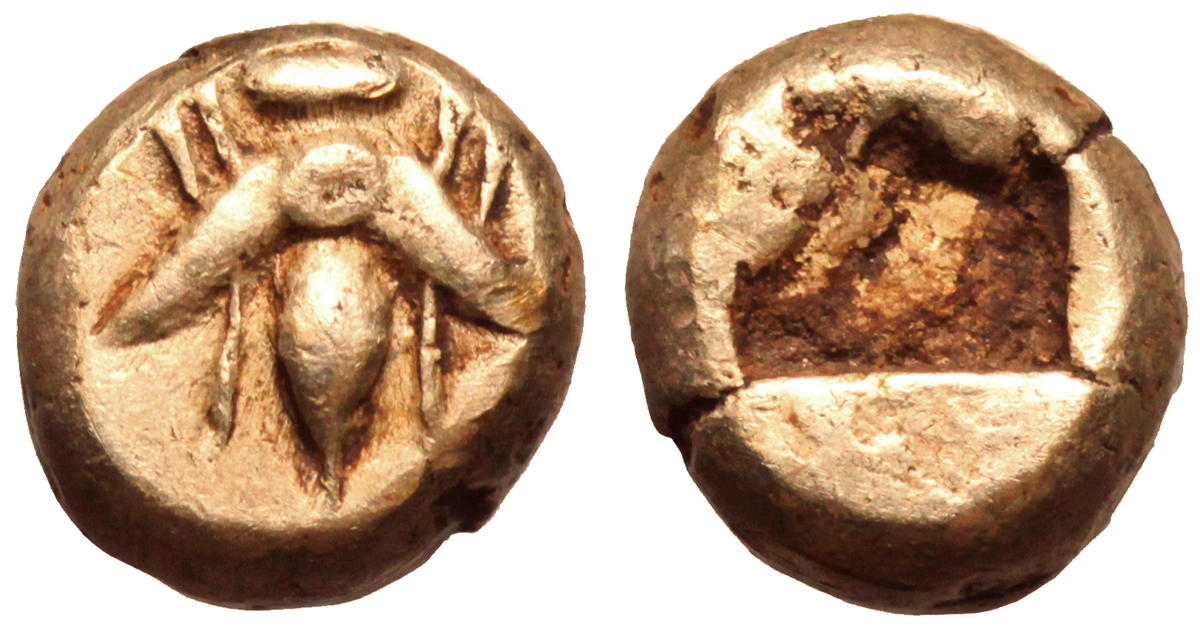S 1599 - Ephesus, electrum, 1/12e staters (550 BCE)
From SILVER
550 BCE - 540 BCE Electrum 237 kg
Description
| ObverseInscription or printing placed on the obverse.: | Bee |
| ReverseInscription or printing placed on the reverse.: | Incuse square |
Mint and issuing power
| MintIdentifies the place of manufacture or issue of a numismatic object.: | Ephesus | Ancient regionAncient region.: | Ionia | Modern countryModern country: Turkey | AuthorityIdentifies the issuing power. The authority can be "pretended" when the name or the portrait of X is on the coin but he/she was not the issuing power. It can also be "uncertain" when there is no mention of X on the coin but he/she was the issuing power according to the historical sources: |
Chronology
| FromIdentifies the initial date in a range assigned in a numismatic context. | 550 BCE | toIdentifies the final date in a range assigned in a numismatic context.. | 540 BCE | PeriodTime period of the numismatic object.: Archaic until 480 BC |
Physical description
| MetalThe physical material (usually metal) from which an object is made.: | Electrum http://nomisma.org/id/el | Median weightMedian of the weights of numismatic objects (in grams). in grams | 1.15 | DenominationTerm indicating the value of a numismatic object. Examples: tetradrachm, chalkous, denarius.: | 1/12th stater | StandardStandard.: | Milesian |
Image

S1599 Ephesus 12e electrum.jpg [1]
References
| Die study referencePublication of the study: | Fischer-Bossert 20191Fischer-Bossert 2019, p. 163, n° 4-6 | ||
| Coin series referenceReference to coin series study: | Karwiese 19952Karwiese 1995, Serie III | ||
Obverse dies distribution
| FrequencyFrequency of specimen in distribution. ᵖ | Number of obversesNumber of obverse dies. ᵖ (o) | % (o) | Number of coinsNumber of coins. (n) | % (n) | Die nameName(s) of the die(s). |
| 3 | 1 | 100 | 3 | 33.33 | 3 |
| 9 | 1 | 100 | 9 | 100 | 2 |
| Total | 2 of 1 | 200 | 12 of 9 | 133.33 |
Reverse dies distribution
no distribution is available
Quantification
| Number of obversesNumber of obverse dies. ᵖ (o) | 1 | Number of singletons (o1)The number of singleton coins. ᵖ | |
| Number of reverse diesNumber of reverse dies. (r) | 2 | Number of coinsNumber of coins. (n) | 9 |
| Coins per obverse dieNumber of coins per obverse die. (n/o) | 9 | Coins per reverse dieNumber of coins per reverse die. (n/r) | 4.5 |
| Reverse per obverse ratioRatio of obverse dies divided by reverse dies. (r/o) | 2 | Percentage of singletons (o1)number of coins (n) divided by the number of singletons (o1) ᵖ | % |
| Original number of dies (O) (Carter 1983 formula)The estimation of the number of coins according to Carter 1983 ᵖ | 1.03 | Coins struck if 20,000 as average productivity per dieCoins made if the average productivity for obverses (according to Carter) is 20,000. ᵖ | 20,600 |
| Original number of dies (O) (Esty 2011 formula)The estimation of the number of coins according to the singleton formula in Esty 2011 ᵖ (O) | 1.13 | Survival rate if 20,000 as average productivity per dieSurvival rate if average productivity is 20,000. ᵖ | 0.00044 |
| Coverage (o = % of O) (Esty 1984 formula)Esty 1984 - coverage (% of O) ᵖ (o = % of O) | % | Die productivity if survival rate 1/2,000Average productivity if survival rate is 1/2,000. ᵖ | 17,475.73 |
| Weight of silver (in kg) if 20,000 coins per die (O = Carter formula)Carter 1983 * Median weight * 20000 (*10 if gold or electrum) ᵖ | 237 kg <br /> 237 kg | Die productivity if survival rate 1/5,000Average productivity if survival rate is 1/5,000. ᵖ | 43,689.32 |
Remarks
References
- ^ Fischer-Bossert, Wolfgang (2019), "Ephesus Switching from Electrum to Silver", in M. Nollé, P. M. Rothenhöfer, G. Schmied-Kowarzik, H. Schwarz, and H. Ch. von Mosch (eds), Panegyrikoi Logoi. Festschrift für Johannes Nollé zum 65. Geburtstag, Bonn, p. 157-171.
- ^ Karwiese, Stefan (1995), Die Münzprägung von Ephesos. I, Die Anfänge : die aeltesten Prägungen und der Beginn der Münzprägung überhaupt, Vienna, 207 p., 9 pl.